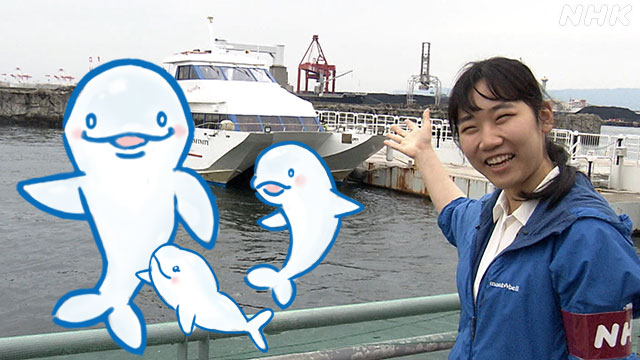Do you know the dolphin companion, finless porpoise?
In fact, they also live in Osaka Bay, and the local aquarium is conducting surveys.
I closely followed the investigation.
(Osaka Broadcasting Station Reporter Nanami Hirose)
I definitely want to see finless porpoise!
Since 2010, the aquarium "Kaiyukan" in Osaka has been conducting surveys on a boat with vocational school students and the general public to learn more about the ecology of finless porpoises.
About 31 people participated in the survey conducted on the 30st.
"I'm looking forward to seeing it for the first time,"
he says, "and I definitely want to see it!"
says finless porpoises during this time of year when they breed and give birth, making it easy to observe them with the naked eye from the boat.
"Is that different?
I thought I found finless porpoises ...
Too bad, it was rubbish.
However, approximately one hour after the start of the survey.
Cheers erupt from inside the ship.
It's a little hard to see, but it seems to be a black shadow on the left side of the screen, multiple finless porpoises.
The finless porpoise was also captured by an NHK helicopter from the sky.
I was able to see the three of them swimming together.
People
who participated in the survey: "I'm very happy" "I really thought about Osaka Bay"
What is finless porpoise
This finless porpoise is a member of the family of small dolphins.
The body length is about 2 meters.
It has a gray body, a rounded forehead and the absence of a dorsal fin.
In Japan, it lives from Kyushu to Tohoku and prefers shallow waters up to 50 m deep.
In the past, finless porpoises were often sighted in Osaka Bay, but it is said that they are becoming difficult to live due to water pollution and coastal reclamation, and Osaka Prefecture has designated them as "species at increasing risk of extinction".
According to Kaiyukan, by investigating finless porpoises that live close to the area of human activity, it is possible to know the richness of the sea and the degree of pollution.
About 31 finless porpoises were confirmed in the survey on the 20st.
In previous surveys, many sightings were found in the sea south of Kansai Airport, but this time they were also found in the sea to the north.
This may be due to the fact that some fishing was closed in the vicinity, but it also suggests that the area of activity is expanding.
A student
who participated in the survey: "I'm glad that I was able to find a lot of finless porpoises, and I would like to continue to participate in the survey because there are many things we don't know about finless porpoises in Osaka Bay."
Shigenori Kondo, Deputy Director
of Educational Affairs at Osaka ECO College
of Animal and Marine Sciences, who accompanied the survey, said, "I would like many people to recognize that the decrease in finless porpoises may be a warning sign for us humans."
Deputy Counselor Osashi Sodeyama, Sub-Manager
of the Sea Animal Environmental Exhibition Team, Breeding and Exhibition Department, Kaiyukan
"People tend to think that Osaka Bay is a dirty sea, but there are a huge abundance of creatures.
Kaiyukan also collects finless porpoise sightings from the public.
Even dead finless porpoises are dissected to investigate what they eat and the effects of the sea.

